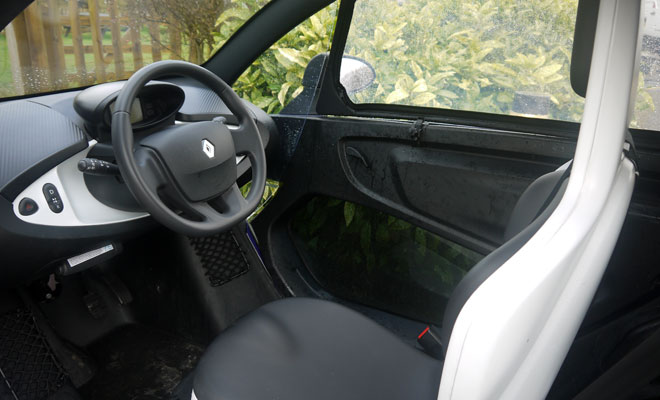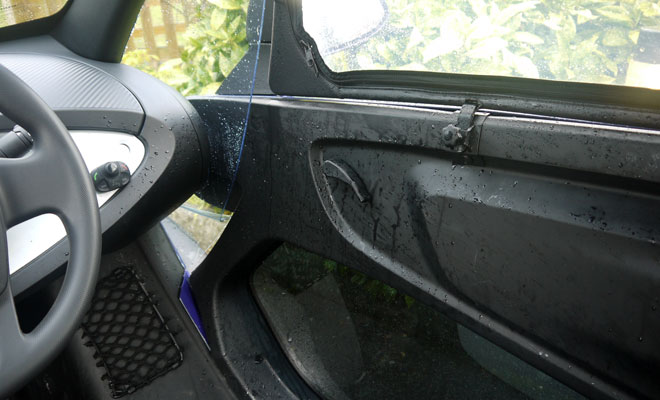by Lem Bingley 
It’s almost two years since I first drove a Renault Twizy, on the sunny Mediterranean island of Ibiza. Ever since I’ve wanted to try out the innovative electric runabout on typical British roads, in typical British weather. Today that wish is granted, in spades. I’m zipping along a bouncy B-road in Surrey and it’s absolutely chucking it down.
And, surprisingly, I’m not soaked. Quite the reverse – I’m warm and dry. Which is helpful, given that I’m not wearing waterproofs and I didn’t bring a change of trousers.

When the Twizy first arrived in the spring of 2012 it was a cheerfully alfresco affair, with optional doors that, if you spent the required £545 to acquire them, arrived without windows. Six months later, with the Twizy’s first winter fast approaching, Renault sensibly announced add-on plastic sidescreens for £295. The Twizy’s simple interior may be tough enough to withstand a jet-washing, but my face is not.
The sidescreens attach by clipping onto the doors, clamped securely in place but readily removable for the warmer months of the year. The transparent window section zips onto a rigid frame, allowing you to unzip a flap of plastic to reach inside for the interior door handle – there is no exterior door handle on a Twizy.
The top of the sidescreen tucks well in under the curve of the Twizy’s roof – sitting far enough in that you need to push or tug it free before the scissor-style door will open. From the outside, you have to tug a small fabric tab. From the inside, there’s no option but to give the plastic window a helping shove.

On the move, in the rain, a Twizy with windows is not remotely watertight. Water flows in through the finger-width gaps that remain ahead of the sidescreens and in around the bottoms of the doors. However, none of the weather ends up in your lap, in your face, or even drips onto your toes. Even driving flat out, at 50mph, through a typical British downpour I’m amazingly not having a bath. It strikes me I’d get a lot wetter waiting for a bus.
The sidescreens do also succeed in keeping the cabin surprisingly cosy. After an evening blast in Ibiza, in the spring, my fingers resembled two pounds of frozen chipolatas. Today, in the UK in February, but with much less blustery wind-chill, my digits are just fine. Indeed at low speed, the Twizy’s windscreen can even start to mist up a bit. Thankfully there are electric heating elements in the screen that will clear it in a jiffy.
So the Twizy is surprisingly effective at keeping the driver snug, but I can’t vouch for the passenger. The bag I flung on the back seat hasn’t yet begun to resemble a sponge, but there is a worryingly large void at the back edge of the sidescreen, which seems designed to cruelly fling rain into a passenger’s face.

At first glance I thought the yawning gap was for getting at the door-handle, but it’s in entirely the wrong place for that. I suspect it’s there to allow the free flow of air, to relieve pressure differentials between inside and out. The same forces that create lift on an aircraft’s wing, or make a soft-top bulge on the motorway, would try to bend flimsy windows outwards were it not for that big gap.
One can, of course, choose to buy a Twizy without doors at all, and thus no option of sidescreens. In that case, I think it would be a good idea to dress as you would for a motorcycle. The rear mudguards are not up to the job of guarding away mud, for example.

The rest of the Twizy remains as I remember it. It’s small, noisy, very hard riding, on the slow side and yet tremendous fun. The unassisted steering provides go-kart agility, and there seems to be plenty of wet grip from the eco-biased tyres. The brakes require a firm foot but aren’t short of stopping power.
In short, the Twizy is ready for life in Britain. Whether Britain is ready for the Twizy is another matter altogether.

Driving a Renault Twizy in the rain
24 February 2014
Read more about: electric cars Renault Twizy



